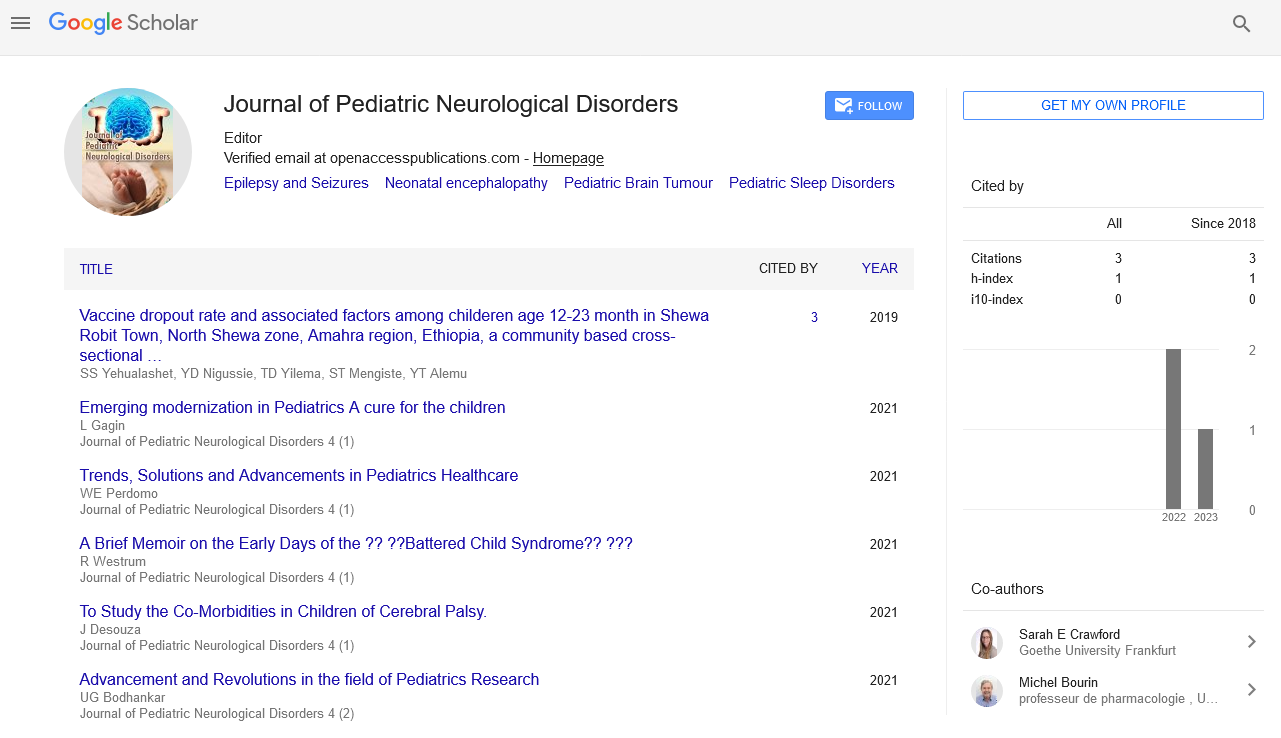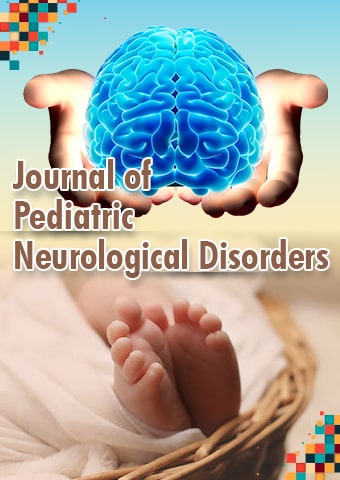Review Article - Journal of Pediatric Neurological Disorders (2023) Volume 6, Issue 4
Children's Traumatic Brain Injury
Linda Hollander*
Pasture Research Center, France
Pasture Research Center, France
E-mail: hollandr45@prc.ac.fr
Received: 01-Aug-2023, Manuscript No. pnn-23-111598; Editor assigned: 07-Aug-2023, PreQC No. pnn-23- 111598(PQ); Reviewed: 14- Aug- 2023, QC No. pnn-23-111598; Revised: 22-Apr-2023, Manuscript No. pnn-23-111598; Published: 31-Aug-2023, DOI: 10.37532/ pnn.2023.6(4).109-111
Abstract
A mild type of Traumatic Brain Injury (TBI), concussion has received a lot of attention in the media. Children with TBI may have compromised visual systems depending on the extent of the injury, which frequently leads to diplopia, suboptimal vision, and problems with visual processing. These kids require careful examination and treatment from orthoptists and ophthalmologists. A multidisciplinary team-based approach to care will be advantageous to many. The evaluation, diagnosis, and long-term follow-up of kids with TBI will all be covered in this symposium.
Keywords
Traumatic brain injury • Diplopia • Suboptimal vision • Ophthalmologists
Introduction
I'd like to extend a warm welcome to the 2019 Sunday Symposium. I am Dr. Geoff Bradford’s cochair for this conference along with the president of the American Association of Certified Orthoptists, Shelley Klein. The National Federation of State High Schools Association reports a gradual drop in youth football participation. The rising concern over the incidence and long-term effects of head injuries on young athletes has corresponded with the increase. It is understandable that parents are concerned about their child's participation in tackle football given that sports and recreational activities account for around 21% of all traumatic brain injuries among American children and adolescents. However, the issues extend far beyond football. A head injury that interferes with normal brain function is known as a traumatic brain injury. The symptoms might be minor, moderate, or severe depending on how serious the trauma was. This symposium will concentrate on mild traumatic brain injury. Is there a certain level of TBI severity below which long-term effects are unlikely? Is one of crucial pragmatic significance. While earlier attempts to answer this topic suggested that the severity threshold is high, this has recently come under scrutiny as it has been clear that there can be serious consequences, especially in the case of repeated mild damage. Contact sports are one important environment for these occurrences, and research on Sports Related Concussion (SRC) has exploded in recent years [1].
The use of bio-markers of injury and the function of computerised pitch-side cognitive assessment are only two of the numerous topics of contention in the field of pediatric concussion. It is unknown how important evidence of subclinical changes in brain physiology is and whether these changes are related to the risk of developing CTE. Concussion is still currently diagnosed clinically and based on symptoms. Until headache, weariness, and psychomotor slowing symptoms have subsided, management is based on rest [2].
Blood biomarkers
Only two of the many hotly debated issues in the realm of pediatric concussion are the use of biomarkers of injury and the purpose of computerized pitch-side cognitive testing. The significance of subclinical alterations in brain physiology and whether or not these changes are connected to the chance of developing CTE remain unknown. Currently, concussions are still diagnosed clinically and according to symptoms. Management is centered on rest (and a veto on returning to play) until symptoms such as headache, exhaustion, and psychomotor slowness have resolved [3].
Although sensitivity over specificity is a necessity for a number of clinical decision rules that have been developed over the past decade, there are still concerns that this results in a significant number of unnecessary CT scans (typically about 10% of the children who visit emergency departments). The potential of circulating blood-borne indicators of injury and the likelihood that they could improve the sensitivity and specificity of identifying serious TBI have come into focus more and more recently. However, it should be highlighted that ‘significant' TBI (e.g., at risk of PCS) does not always equate to TBI requiring neurosurgical evaluation [4].
The potential of circulating blood-borne indicators of injury and the likelihood that they could improve the sensitivity and specificity of identifying serious TBI have come into focus more and more recently. However, it should be highlighted that' significant' TBI (e.g., at risk of PCS) does not always equate to TBI requiring neurosurgical evaluation [5].
Oversight of severe traumatic brain injury
Although in many ways the central paradigm of ICU management has remained frustratingly unchanged over several decades, it continues to be one of maintaining Cerebral Perfusion Pressure (CPP) in the face of causes of raised Intracranial Pressure (ICP), either through medical or surgical management. Delivering an acutely injured child to a trauma center with expertise in managing pediatric TBI improves survival. Surgery for severe traumatic brain injury (TBI) continues to be centered on removing space-occupying conditions like hematomas, contusions, and depressed skull fragments, as well as maintaining a normal ICP (typically 20 mmHg) and optimal CPP (>40 - 50 mmHg) with Cerebrospinal Fluid (CSF) diversion or decompressive craniectomy. Decompressive craniectomy is still debatable, and its function, particularly in pediatric TBI, is still not fully understood [6 ].
Some of the debates around the use of decompressive craniectomy in children centre on the challenges of caring for a child with a significant cranial deformity. Disrupted CSF dynamics (including hydrocephalus and hygromas), infection, seizures, and syndrome of the trephined are somewhat common surgical complications. The understanding of risk factors for these complications has improved as a result of robust multi-center data collection activities [7].
After trauma rehabilitation
Rehabilitation continues to be the cornerstone of the clinical response to TBI in the postacute phase. According to epidemiological studies, motor results following TBI are typically better than those following various other types of acquired brain injury, especially anoxic brain injury. They further confirm that following a severe TBI, improvements in gross motor function can last for years with continued, intense therapy. The cognitive and behavioural morbidities following TBI are more significant for many young people. The vast majority of pediatric TBI survivors 'walk and talk' and make superficially good recoveries, but they also experience typical, frequently ignored, and underappreciated cognitive deficits, the effects of which tend to compound over the remaining years of development into adulthood and have an especially negative impact on education [8].
These concerns relate to the age-at-injury effects in TBI discussion that has been going on for a while, specifically whether any possible advantages of "greater plasticity" in the developing brain outweigh the necessity to complete development and "make a year's progress every year" with an injured brain. Because of the confounds between age and specific damage mechanisms and severity, empirical evidence is more difficult to come by than one may initially think. A significant study found that very young people with injuries have poor late outcomes [9].
Late outcome
Executive function, new learning, impulse control, difficulty reading social situations and conversation (e.g., a tendency to interpret ironic, sarcastic, or figurative comments over-literally), and challenges with "emotional mindreading" are all typical cognitive problems following TBI. These elements are significant risk factors for aggressive and violent behaviour, and there is a well-established link between prior TBI and criminal behaviour. The population of prisoners has relatively high rates of prior history of TBI, according to earlier research and meta-analysis. Whether these relationships are causal or whether the occurrence of TBI is an epiphenomenon, reflecting socioeconomic disadvantage and other characteristics mentioned at the top of this study, has long been a source of debate. The association may be more directly causal than previously thought, according to a significant review, which has important consequences for public health and policy by designating the TBI survivor population as a population deserving of psychological, emotional, and educational care [10].
Conclusion
Pediatric TBI is still a significant public health issue because of the intricate relationships between the damage and the developing child's brain. Parental coping is a key factor in outcome. Two significant studies from 2018 on mild and mild-to-moderate TBI supported earlier findings that over time after injury, behavioural and other symptom reports are more closely related to psychological risk factors for children and families than to the severity of the injury itself. They are at least injury-independent prospective targets for intervention, even if changing them will probably be difficult.
References
- Choe M, Barlow KM. Pediatric traumatic brain injury and concussion. Minneap Minn. 24,300-311 (2018).
- Yang CC, Chiu HC, Xiao SH. Iatrogenic effect? Cautions when utilizing an early health education for postconcussion symptoms. Arch Clin Neuropsychol. 33,131-142 (2018).
- Minney MJ, Roberts RM, Mathias JL. Service and support needs following pediatric brain injury: perspectives of children with mild traumatic brain injury and their parents. Brain Inj. 33, 168-182 (2019).
- Fiandaca MS, Mapstone M, Mahmoodi A. Plasma metabolomic bio markers accurately classify acute mild traumatic brain injury from controls. PLoS One.13, 0195318 (2018).
- Wu T, Merkley TL, Wilde EA. A preliminary report of cerebral white matter microstructural changes associated with adolescent sports concussion acutely and subacutely using diffusion tensor imaging. Brain Imaging Behav.12, 962-973 (2018).
- Hanks R, Millis S, Scott S. The relation between cognitive dysfunction and diffusion tensor imaging parameters in traumatic brain injury. Brain Inj. 33, 355-363 (2019).
- Hanks R, Millis S, Scott S. The relation between cognitive dysfunction and diffusion tensor imaging parameters in traumatic brain injury. Brain Inj. 33, 355-363 (2018).
- Morrison A, Houtrow A, Zullo J. Neurostimulant prescribing patterns in children admitted to the intensive care unit after traumatic brain injury. J Neurotrauma.36, 293-299 (2019).
- Labrell F, Camara Costa H, Dufour C. Parental stress and paediatric acquired brain injury. Brain Inj. 32, 13-14 (2018).
- Bursnall S, Kendall E, Degeneffe CE. Regaining equilibrium: understanding the process of sibling adjustment to pediatric acquired brain injury. Rehabil Psychol. 63, 447-459 (2018).
Indexed at, Crossref, Google Scholar
Indexed at, Crossref, Google Scholar
Indexed at, Crossref, Google Scholar
Indexed at, Crossref, Google Scholar
Indexed at, Crossref, Google Scholar
Indexed at, Crossref, Google Scholar
Indexed at, Crossref, Google Scholar
Indexed at, Crossref, Google Scholar
Indexed at, Crossref, Google Scholar

